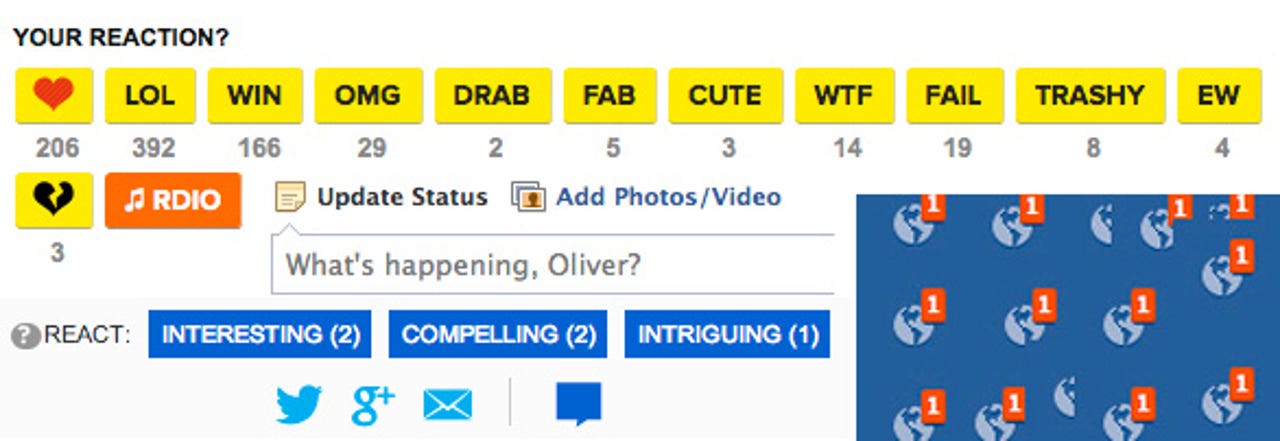Reaction overload...


What a strangely claustrophobic place the post Web 2.0 digital universe has become. We've gone from the early participatory 'read write web' of Wikipedia to hosted walled garden sites and digital services, led by Facebook. The early collaborative crowd sourcing has largely given way to a sophisticated world of digital cliques and keeping up with the digital Joneses, and the pressure to reveal your thoughts and reactions has reached a tipping point. Few people update Wikipedia these days, and the sheer volume of mobile applications has led to app exhaustion - the novelty of having hundreds of buttons on your phone and constantly foraging for shiny new ones having worn off for most people.
Once digital buzzwords make it to inflight magazine articles you can be sure they are past their sell-by date, and similarly book publishing lead times mean their shelf life can be measures in months...assuming they're not already out of date when they hit Amazon and the conference circuit. Back in the Web 1.0 days (AOL was that era's Facebook equivalent with its advertising keywords) the term 'surfing the web' was popular. Speaking as someone who occasionally flails around in the ocean attempting to catch waves I can attest to how time consuming, complex and competitive for the few rideable waves 'real' surfing is - 'grazing' the web would be a much more accurate description.
The cross currents of how we use digital technology for different aspects of our lives have never been deeper - but the superficial grazing aspects - the 'surfing' for freebies, shiny objects and quick fix stimulation and reaction has hit new focus time lows and an all time high tsunami of light weight 'content' vying for consumption. The image I made above is a composite of various visual cues to encourage you to interact with sites, which of course are all trackable and monetizable by the site owners. (The Pavlovian Facebook 'world message number alert' most people know by now…other sources were weather.com(!) and a couple of other tabloid style websites). Despite how trivial it is to click a button to react, reaction request exhaustion seems to be increasing as the novelty wears off.
The casual 'in your own time' digital world of social networks, cat videos and gimmicky apps has had a pretty disastrous impact on understanding of the way we work together, as I've written here previously. Nevertheless the other side of that coin is a maturity now around consumer facing companies leveraging and taking advantage of our ever more interconnected world to interactively tune in to customer perspectives on their products.
Historically over the last century the big ad agencies have organized the breathing of life and character into global brands to educate us all on their attributes - the enterprises creating the actual products focused on measuring everything ( ...“If you can't measure it, you can't manage it" ...Peter Drucker...) from marketing effectiveness to lean manufacturing techniques.
The explosion of interest in profiting from digital marketing interactions on modern social networks, aligned with the deep roots of traditional enterprise Customer Relationship Management software has been the most visibly actionable part of 'digital transformation', not least because it could lead to sales the enterprise bean counters can measure and smile about.
The gradual evolution of the traditional conservative enterprise way of doing business (simplistically documents and spreadsheets for small measuring jobs, resource planning and financial software for the bigger stuff) has been mostly painfully slow to accommodate digital societal changes.
Business context is everything, and there have been many false starts as generations of software fail to meet strategic and tactical value needs. The waves of 'social' prefix buzzwords launched at a thousand sales kickoffs were all too frequently wide of the mark, with software vendors believing their own hype and with their prospects growing increasingly jaded and cynical.
The combination of ever shorter attention span digital natives - we're pretty much all digital natives now regardless of age groups - and the creaking of last century enterprise infrastructure has of course been the subject of many VC funded attempts at disruption of the software market, and they are a pretty noisy bunch also. Add to this rapidly maturing digital fabric the age old issue of office politics and you have a pretty heady cocktail of conflicting currents that can often nullify attempts to move forward, with stasis one of the reasons for tumbleweed city deserted collaborative environments inside companies.
The solution to these issues never changes: keep focus on desired results while identifying the right tools to get the job done and measurable. The challenge is that different parts of a company have different needs - the 'one size fits all' enterprise is no longer staffed by job-for-life employees, and individuals and cliques are increasingly looking out for their own interests.
We're now well into an era of the blending and absorption of the 'new' world with the old, with constant innovation a key driving force that propels business forward, both collectively and individually. How that innovation is defined in modern companies is arguably the sharp end of future competitiveness and relevance, and the only practical way to cut through the digital clutter….